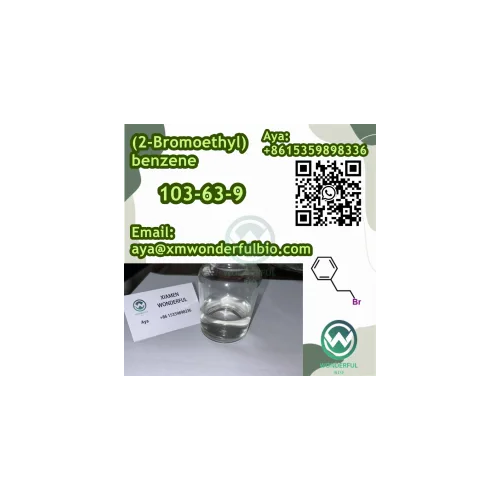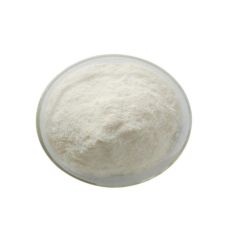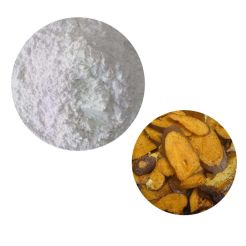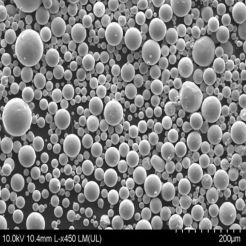CAS 103-63-9 (2-Bromoethyl)benzene
(2-Bromoethyl)benzene, also known as α-bromoethylbenzene, is a colourless to light yellow, highly flammable chemical.It is an important intermediate in the synthesis of pharmaceuticals, agrochemicals, and other organic compounds.
Product Description
(2-Bromoethyl)benzene, also known as α-bromoethylbenzene, is a colourless to light yellow, highly flammable chemical.It is an important intermediate in the synthesis of pharmaceuticals, agrochemicals, and other organic compounds.
CAS Number: 103-63-9
Chemical Name: (2-Bromoethyl)benzene
Alternative Names: 2-Bromomethylbenzene, 103-63-9
Formula: C8H9Br
Molecular Weight: 185.06 g/mol
Appearance: Colorless to light yellow liquid
Purity: ≥98%
Boiling Point: 190-192°C
Density: 1.345 g/mL
Solubility: Insoluble in water; soluble in organic solvents
Storage: Store in a cool, dry place. Keep container tightly closed.
Usage: (2-Bromoethyl)benzene, also known as 2-Bromomethylbenzene, is a versatile chemical intermediate used in various organic synthesis reactions. It is commonly employed in the pharmaceutical, agrochemical, and chemical industries for the production of diverse compounds.
Physical and Chemical Properties:
(2-Bromoethyl)benzene is a highly reactive compound, and it is soluble in almost all common organic solvents like benzene, toluene, and ether. It has a boiling point of 214 degrees Celsius, a melting point of -45 degrees Celsius, and a flash point of 98 degrees Celsius. Under normal conditions, it has a density of 1.39 g/ml.
Applications:
(2-Bromoethyl)benzene is widely used as an intermediate in the manufacturing of a range of organic compounds such as agrochemicals, antibiotics, and other simple organic compounds like alcohols, ketones, and acids. Some of the most common applications of the chemical are given below:
1. Agricultural Chemicals:
(2-Bromoethyl)benzene is an important raw material used in the production of several agricultural chemicals, including fungicides, herbicides, and other crop protection products. These chemicals help farmers control pests and protect their crops from disease, ultimately leading to higher crop yields.
2. Pharmaceuticals:
In the pharmaceutical industry, (2-Bromoethyl)benzene serves as an important intermediate for the synthesis of several active pharmaceutical ingredients (APIs). These APIs can be used in a wide range of medicinal products, including pain relievers, anti-inflammatory drugs, and antidepressants.
3. Dyes and Pigments:
(2-Bromoethyl)benzene is also a vital chemical used in the production of dyes and pigments, where it serves as an intermediate for the synthesis of various organic compounds used in these applications.
4. Polymer Manufacturing:
(2-Bromoethyl)benzene is also used as an intermediate for the manufacturing of polymers like polyvinyl chloride (PVC) and polyurethane (PU), among others. These materials are widely used in the construction, automotive, and consumer goods industries.
5. Chemical Synthesis:
(2-Bromoethyl)benzene can be used as a reagent in several chemical reactions. It can undergo nucleophilic substitution reactions with various nucleophiles such as amines and amides, or undergo cross-coupling reactions with palladium catalysts.
Safety Considerations:
(2-Bromoethyl)benzene is a highly reactive and dangerous chemical. It can cause skin and eye irritation, and prolonged exposure can lead to serious health problems. Proper protective equipment, including gloves, goggles, and a lab coat should be worn while handling the compound. In addition, specific precautions should be taken during the transport, storage, and handling of the chemical to avoid dangerous incidents.
(2-Bromoethyl)benzene is an important chemical which serves essential roles in a range of industrial applications. It is a reagent, intermediate, and building block for a wide range of organic compounds used in pharmaceuticals, agrochemicals, dyes and pigments, polymer manufacturing, and other applications. However, precautions must be taken while handling the chemical, and it should be treated with care to avoid any dangerous incidents.



